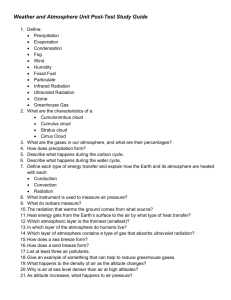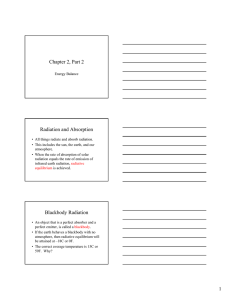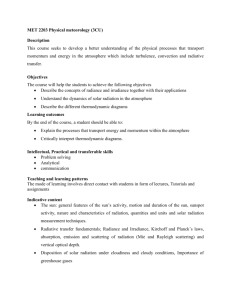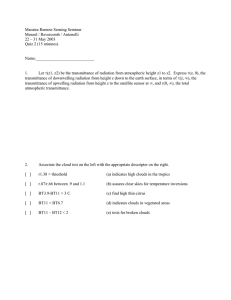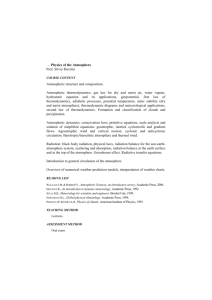Review of Remote Sensing Basic Theory Quick
advertisement
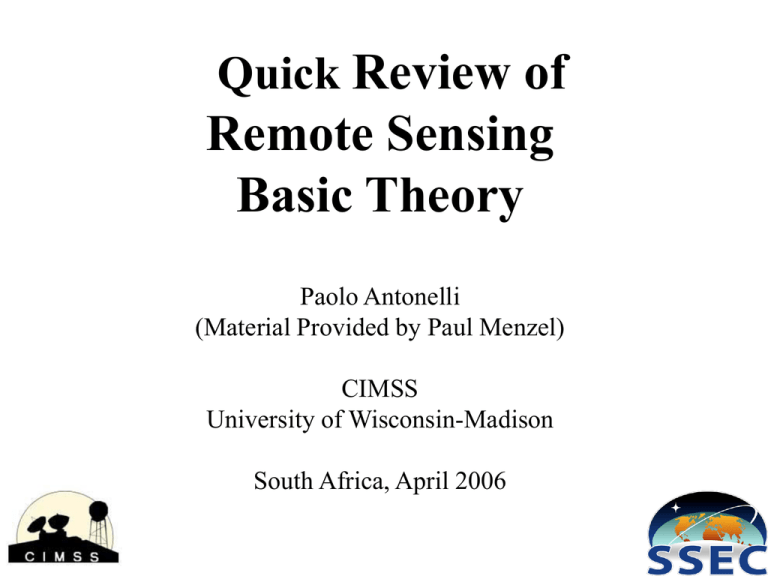
Quick Review of
Remote Sensing
Basic Theory
Paolo Antonelli
(Material Provided by Paul Menzel)
CIMSS
University of Wisconsin-Madison
South Africa, April 2006
Outline
• Bit Depth
• Radiative Transfer Equation in the IR
2
Visible
(Reflective Bands)
Infrared
(Emissive Bands)
3
Low Gain Channels
Band 14 low
0.68 µm
Vegetated areas
Are visible
Saturation over
Barren Soil
Visible details
over water
4
High Gain Channels
Band 14 hi
0.68 µm
Saturation over
Vegetated areas
little barely visible
Saturation over
Barren Soil
Visible details
over water
5
Range for Band 14 low
0.68 µm
Range for Band 14 high
0.68 µm
6
Bit Depth and Value Range
• With 12 bits 212 integer numbers can be represented
– Given ∆R, the range of radiances we want to observe, the
smallest observable variation is ∆R/ 212
– Given dR smallest observable variation, the range of
observable radiances is dR* 212
For this reason Band 14low (larger range) is used for cloud
detection and Band 14hi (smaller range) is used for ocean
products
dR
∆R
7
Visible
(Reflective Bands)
Infrared
(Emissive Bands)
Radiative Transfer Equation
in the IR
8
Relevant Material in Applications of Meteorological Satellites
CHAPTER 2 - NATURE OF RADIATION
2.1
Remote Sensing of Radiation
2.2
Basic Units
2.3
Definitions of Radiation
2.5
Related Derivations
2-1
2-1
2-2
2-5
CHAPTER 3 - ABSORPTION, EMISSION, REFLECTION, AND SCATTERING
3.1
Absorption and Emission
3.2
Conservation of Energy
3.3
Planetary Albedo
3.4
Selective Absorption and Emission
3.7
Summary of Interactions between Radiation and Matter
3.8
Beer's Law and Schwarzchild's Equation
3.9
Atmospheric Scattering
3.10
The Solar Spectrum
3.11
Composition of the Earth's Atmosphere
3.12
Atmospheric Absorption and Emission of Solar Radiation
3.13
Atmospheric Absorption and Emission of Thermal Radiation
3.14
Atmospheric Absorption Bands in the IR Spectrum
3.15
Atmospheric Absorption Bands in the Microwave Spectrum
3.16
Remote Sensing Regions
3-1
3-1
3-2
3-2
3-6
3-7
3-9
3-11
3-11
3-11
3-12
3-13
3-14
3-14
CHAPTER 5 - THE RADIATIVE TRANSFER EQUATION (RTE)
5.1
Derivation of RTE
5.10
Microwave Form of RTE
5-1
5-28
9
Energy conservation
+a+r=1
=B(Ts)
T
+a+r=1
10
Simple case with no atmosphere and opaque cloud
Tc=220 K
surface
B=B(Ts)
Ts=300 K
B=B(Tc)
cloud
11
Simple case with no atmosphere and semi-trasparent cloud
Tc=220 K
surface
B=B(Ts)
Ts=300 K
=1-
B=B(Tc)+ B(Ts) )
12
Radiative Transfer Equation
13
Transmittance for Window
Channels
+a+r=1
z
zN
close to 1
a close to 0
The molecular species in the
atmosphere are not very active:
•most of the photons emitted by the
surface make it to the Satellite
• if a is close to 0 in the atmosphere
then is close to 0, not much
contribution from the atmospheric
layers
z2
z1
1
14
Trasmittance for Absorption
Channels
z
Absorption Channel:
close to 0
a close to 1
zN
One or more molecular species in the
atmosphere is/are very active:
•most of the photons emitted by the
surface will not make it to the
Satellite (they will be absorbed)
• if a is close to 1 in the atmosphere
then is close to 1, most of the
observed energy comes from one or
more of the uppermost atmospheric
layers
z2
z1
1
15
Spectral Characteristics of
Atmospheric Transmission and Sensing Systems
16
Weighting Functions
zN
zN
z2
z1
z2
z1
1
d/dz
17
MODIS IR Spectral Bands
MODIS
H
CO
O2O
32
MODIS absorption bands
19
Emission, Absorption
Blackbody radiation B represents the upper limit to the amount of radiation that a real
substance may emit at a given temperature for a given wavelength.
Emissivity is defined as the fraction of emitted radiation R to Blackbody radiation,
= R /B .
In a medium at thermal equilibrium, what is absorbed is emitted (what goes in comes out) so
a = .
Thus, materials which are strong absorbers at a given wavelength are also strong emitters at
that wavelength; similarly weak absorbers are weak emitters.
20
Transmittance
Transmission through an absorbing medium for a given wavelength is governed by
the number of intervening absorbing molecules (path length u) and their absorbing
power (k) at that wavelength. Beer’s law indicates that transmittance decays
exponentially with increasing path length
(z ) = e
- k u (z)
where the path length is given by
u (z) = dz .
z
k u is a measure of the cumulative depletion that the beam of radiation has
experienced as a result of its passage through the layer and is often called the optical
depth .
Realizing that the hydrostatic equation implies g dz = - q dp
where q is the mixing ratio and is the density of the atmosphere, then
p
u (p) = q g-1 dp
o
and
(p o ) = e
- k u (p)
21
.
Emission, Absorption, Reflection, and Scattering
If a, r, and represent the fractional absorption, reflectance, and transmittance,
respectively, then conservation of energy says
a + r + = 1 .
For a blackbody a = 1, it follows that r = 0 and = 0 for blackbody radiation. Also, for a
perfect window = 1, a = 0 and r = 0. For any opaque surface = 0, so radiation is either
absorbed or reflected a + r = 1.
At any wavelength, strong reflectors are weak absorbers (i.e., snow at visible wavelengths),
and weak reflectors are strong absorbers (i.e., asphalt at visible wavelengths).
22
Radiative Transfer Equation
The radiance leaving the earth-atmosphere system sensed by a
satellite borne radiometer is the sum of radiation emissions
from the earth-surface and each atmospheric level that are
transmitted to the top of the atmosphere. Considering the
earth's surface to be a blackbody emitter (emissivity equal to
unity), the upwelling radiance intensity, I, for a cloudless
atmosphere is given by the expression
I = sfc B( Tsfc) (sfc - top) +
layer B( Tlayer) (layer - top)
layers
where the first term is the surface contribution and the second
term is the atmospheric contribution to the radiance to space.
23
In standard notation,
I = sfc B(T(ps)) (ps) + (p) B(T(p)) (p)
p
The emissivity of an infinitesimal layer of the atmosphere at pressure p is equal
to the absorptance (one minus the transmittance of the layer). Consequently,
(p) (p) = [1 - (p)] (p)
Since transmittance is an exponential function of depth of absorbing constituent,
p+p
p
(p) (p) = exp [ - k q g-1 dp] * exp [ - k q g-1 dp] = (p + p)
p
o
Therefore
(p) (p) = (p) - (p + p) = - (p) .
So we can write
I = sfc B(T(ps)) (ps) - B(T(p)) (p) .
p
which when written in integral form reads
ps
I = sfc B(T(ps)) (ps) - B(T(p)) [ d(p) / dp ] dp .
o
24
When reflection from the earth surface is also considered, the Radiative Transfer
Equation for infrared radiation can be written
o
I = sfc B(Ts) (ps) + B(T(p)) F(p) [d(p)/ dp] dp
ps
where
F(p) = { 1 + (1 - ) [(ps) / (p)]2 }
The first term is the spectral radiance emitted by the surface and attenuated by
the atmosphere, often called the boundary term and the second term is the
spectral radiance emitted to space by the atmosphere directly or by reflection
from the earth surface.
The atmospheric contribution is the weighted sum of the Planck radiance
contribution from each layer, where the weighting function is [ d(p) / dp ].
This weighting function is an indication of where in the atmosphere the majority
of the radiation for a given spectral band comes from.
25
Mathematical Derivation of the Radiative Transfer Equation
Schwarzchild's equation
At wavelengths of terrestrial radiation, absorption and emission are equally
important and must be considered simultaneously. Absorption of terrestrial
radiation along an upward path through the atmosphere is described by the relation
-dLλabs = Lλ kλ ρ sec φ dz .
Making use of Kirchhoff's law it is possible to write an analogous expression for
the emission,
dLλem = Bλ dλ = Bλ daλ = Bλ kλ ρ sec φ dz ,
where Bλ is the blackbody monochromatic radiance specified by Planck's law.
Together
dLλ = - (Lλ - Bλ) kλ ρ sec φ dz .
26
This expression, known as Schwarzchild's equation, is the basis for computations
of the transfer of infrared radiation.
Schwarzschild to RTE
dLλ = - (Lλ - Bλ) kλ ρ dz
but
so
d = k ρ dz since
= exp [- k ρ dz].
z
dLλ = - (Lλ - Bλ) d
dLλ + Lλ d = Bλd
d (Lλ ) = Bλd
Integrate from 0 to
and
Lλ ( ) ( ) - Lλ (0 ) (0 ) = Bλ [d /dz] dz.
0
Lλ (sat) = Lλ (sfc) (sfc) + Bλ [d /dz] dz.
0
27
Earth emitted spectra overlaid on Planck function envelopes
O3
CO2
H20
CO2
Weighting Functions
Longwave CO2
14.7
1
14.4
2
14.1
3
13.9
4
13.4
5
12.7
6
12.0
7
680
696
711
733
748
790
832
Midwave H2O & O3
11.0
8
907
9.7
9
1030
7.4
10
1345
7.0
11
1425
6.5
12
1535
CO2, strat temp
CO2, strat temp
CO2, upper trop temp
CO2, mid trop temp
CO2, lower trop temp
H2O, lower trop moisture
H2O, dirty window
window
O3, strat ozone
H2O, lower mid trop moisture
H2O, mid trop moisture
H2O, upper trop moisture
29
RTE in Cloudy Conditions
Iλ = η Icd + (1 - η) Ic where cd = cloud, c = clear, η = cloud fraction
λ
λ
o
Ic = Bλ(Ts) λ(ps) + Bλ(T(p)) dλ .
λ
ps
pc
Icd = (1-ελ) Bλ(Ts) λ(ps) + (1-ελ) Bλ(T(p)) dλ
λ
ps
o
+ ελ Bλ(T(pc)) λ(pc) + Bλ(T(p)) dλ
pc
ελ is emittance of cloud. First two terms are from below cloud, third term is cloud
contribution, and fourth term is from above cloud. After rearranging
pc
dBλ
Iλ - Iλc = ηελ (p)
dp .
ps
dp
Techniques for dealing with clouds fall into three categories: (a) searching for
cloudless fields of view, (b) specifying cloud top pressure and sounding down to
cloud level as in the cloudless case, and (c) employing adjacent fields of view to
determine clear sky signal from partly cloudy observations.
Cloud Properties
RTE for cloudy conditions indicates dependence of cloud forcing
(observed minus clear sky radiance) on cloud amount () and cloud top
pressure (pc)
pc
(I - Iclr) = dB .
ps
Higher colder cloud or greater cloud amount produces greater cloud
forcing; dense low cloud can be confused for high thin cloud. Two
unknowns require two equations.
pc can be inferred from radiance measurements in two spectral bands
where cloud emissivity is the same. is derived from the infrared
window, once pc is known. This is the essence of the CO2 slicing
technique.
Conclusion
• Bit Depth: given the range of observable
values characterizes the minimal detectable
variation in radiance and/or reflectance;
• Radiative Transfer Equation (IR): models the
propagation of terrestrial emitted energy
through the atmosphere
32

